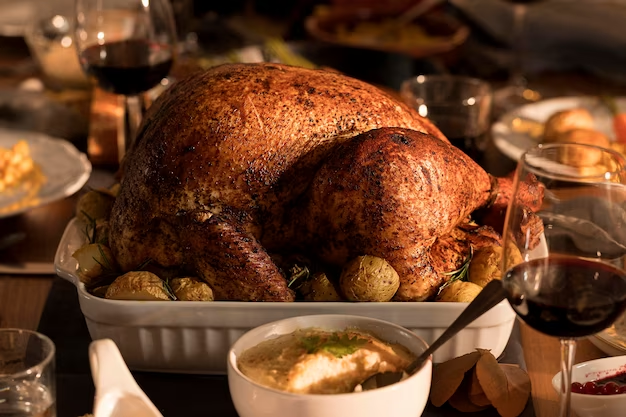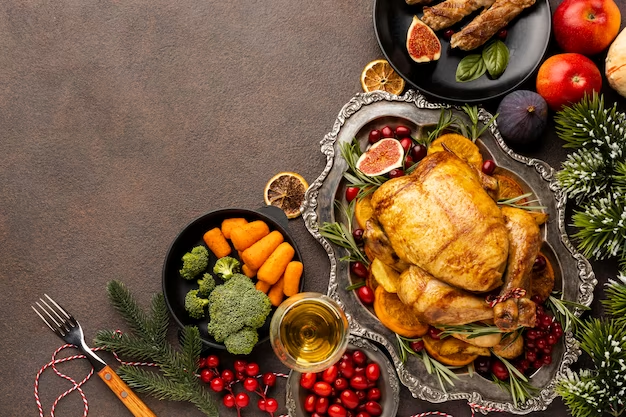Can you eat turkey that was left out all night?
What is the Risk?
Leaving raw turkey out at room temperature for too long can increase the risk of foodborne illness. Harmful bacteria can grow rapidly in turkey that is kept at temperatures between 40°F and 140°F, known as the “danger zone.” This means that if you leave your turkey out all night, you could be exposing yourself and your family to dangerous bacteria such as Salmonella, Campylobacter, and E. coli.

Food poisoning can cause symptoms such as an upset stomach, vomiting, diarrhea, and fever. In severe cases, it can even lead to hospitalization and even death. It’s simply not worth the risk to leave your turkey out all night and hope for the best.
Modern food scientists recommend following food safety guidelines to prevent foodborne illness from raw turkey. To ensure the safety and quality of your turkey, it’s important to keep it refrigerated at a temperature below 40°F or frozen at 0°F until it’s time to cook.
When cooking your turkey, be sure to use a food thermometer to check the internal temperature. The temperature should reach at least 165°F for the turkey to be safe to eat. This will ensure that harmful bacteria have been destroyed during cooking.
If you do have leftover turkey, be sure to store it properly by refrigerating it within two hours of cooking. Leftover turkey should be consumed within three to four days. If you’re not going to eat it within that time frame, it’s best to freeze it.
In summary, leaving turkey out all night can be dangerous. Don’t take the risk of foodborne illness. Follow food safety guidelines to ensure the safety and quality of your turkey dinner.
Dangers of Eating Unrefrigerated Food
Eating food that has been left out at room temperature for an extended period of time can be dangerous, and even deadly, due to the growth of harmful bacteria. When perishable food like meat, dairy products, and cooked leftovers are left unrefrigerated, the temperature danger zone is breached, making it a perfect breeding ground for harmful bacteria to thrive.
According to the Food and Drug Administration (FDA), the temperature danger zone is between 40°F and 140°F. Bacteria can grow rapidly at temperatures between these ranges, which can cause food poisoning, and other related illnesses.
Some common symptoms of food poisoning include nausea, vomiting, abdominal pain, diarrhea, fever, and chills. In severe cases, food poisoning can cause dehydration, kidney failure, and even death. People with weakened immune systems, young children, pregnant women, and the elderly are at a higher risk of developing serious complications from food poisoning.
It’s essential to adhere to food safety guidelines, particularly when it comes to the storage and preparation of food. Always refrigerate perishable food, including meat, eggs, dairy products, and cooked leftovers within two hours after cooking or purchasing it. If the room temperature is hotter than 90°F, the food should be refrigerated within an hour.
It is also important to ensure that cooked food is reheated to the correct internal temperature before eating. Use a food thermometer to check the internal temperature of your food, and make sure it reaches at least 165°F to kill off any harmful bacteria that may have grown.

Overall, it’s essential to take food safety seriously and prioritize it in your kitchen. By following proper food handling and storage guidelines, you can protect yourself and your loved ones from the dangers of foodborne illness.
How Long Can You Leave Raw Turkey Out?
If you’re planning on cooking a turkey for a holiday or special occasion, it’s important to remember to store the raw turkey correctly to prevent the growth of harmful bacteria. Leaving raw turkey out at room temperature can lead to the growth of dangerous bacteria that can cause food poisoning.
According to modern food scientists, raw turkey should not be left out at room temperature for more than two hours. In the temperature danger zone between 40°F and 140°F, bacteria can start to multiply rapidly, doubling every 20 minutes. This means that leaving raw turkey out for an extended period can lead to the growth of harmful bacteria that can cause foodborne illness.
It’s important to note that this two-hour limit is not cumulative. This means that you cannot leave the turkey out for one hour, put it back in the fridge, and then take it out again for another hour. Each time the turkey is left out for more than two hours, the risk of harmful bacteria growth increases.
To ensure the safety of your turkey and prevent the growth of harmful bacteria, it’s best to either refrigerate or freeze it immediately after purchasing. If you need to thaw the turkey, it’s best to do so in the refrigerator or cold water. Avoid thawing the turkey on the counter as this can promote bacterial growth.
In summary, the rule of thumb when it comes to raw turkey is to not leave it out at room temperature for more than two hours. Adhering to proper food safety guidelines can help prevent foodborne illness and ensure a safe and enjoyable meal for everyone.
Temperature Guidelines for Safely Eating Cooked or Raw Turkey
When it comes to preparing and serving turkey, there are some important temperature guidelines that you need to follow to ensure the safety of your food. Whether you’re cooking a whole turkey for Christmas dinner or just enjoying a turkey sandwich for lunch, it’s crucial that you understand the right temperatures for both cooked and raw meat.
Firstly, let’s talk about raw turkey. Raw meat, including turkey, can carry harmful bacteria such as salmonella and campylobacter, which can cause food poisoning if not cooked properly. To avoid this, it’s important to always handle raw turkey with care and follow proper food hygiene protocols, such as washing your hands and avoiding cross-contamination.
To ensure the turkey is safe to eat, you need to make sure the internal temperature reaches 165°F (74°C). Use a meat thermometer and insert it into the thickest part of the turkey, making sure it doesn’t touch any bone. This temperature kills any harmful bacteria and ensures the meat is thoroughly cooked.
When it comes to cooked turkey, it’s important to keep it at the right temperature to prevent bacterial growth. Once the turkey has been cooked and put out for serving, it should be kept at a temperature above 140°F (60°C) to prevent any bacteria from multiplying. If serving the turkey buffet-style, consider using a warming tray or chafing dish to keep it at the right temperature.
If you have leftover turkey, it’s important to store it safely in the refrigerator within two hours of it being cooked. This can be done by slicing the meat or separating it from the bones and storing it in an airtight container. When reheating leftovers, make sure the internal temperature of the turkey reaches 165°F (74°C) to ensure it’s safe to eat.

In conclusion, when preparing and serving turkey, it’s important to follow the correct temperature guidelines to ensure the safety of your food. Whether it’s raw or cooked, make sure you use a meat thermometer to check the internal temperature of the turkey and keep it at the right temperature to prevent bacterial growth. By following these guidelines, you can enjoy a delicious turkey meal without any worries of foodborne illness.